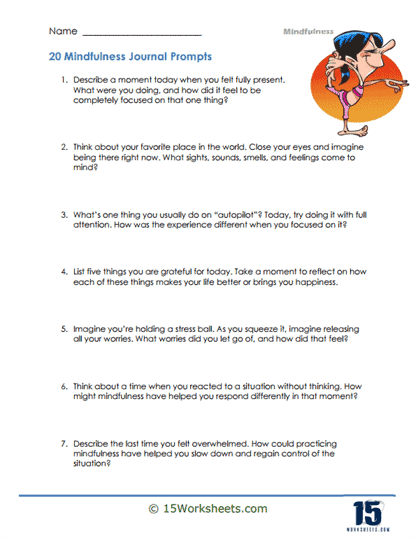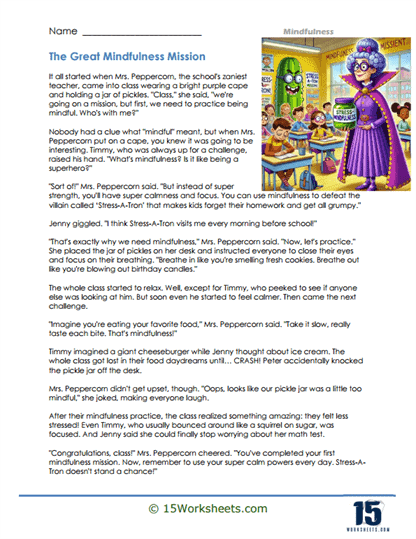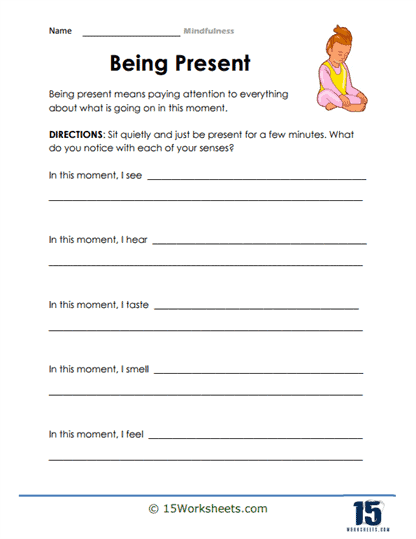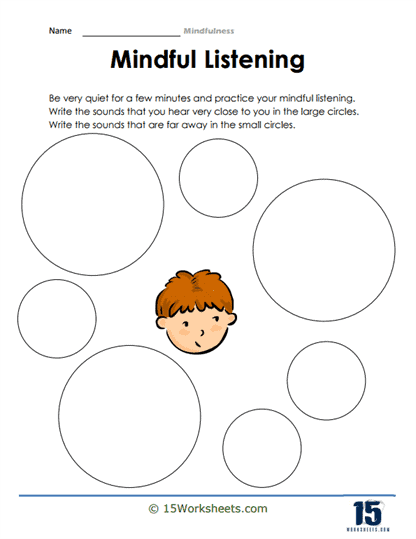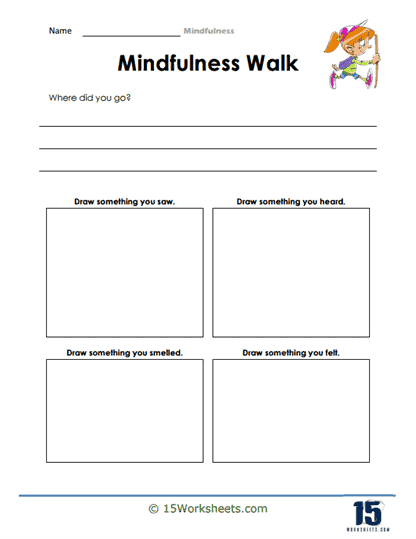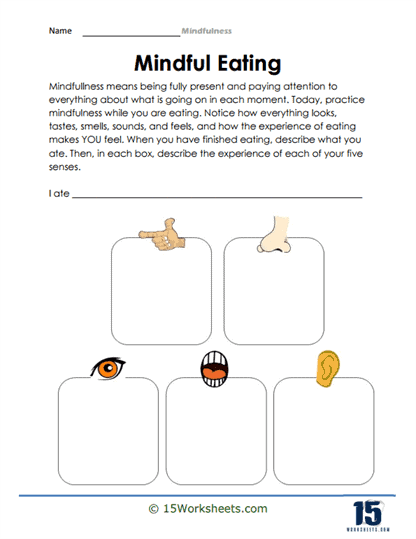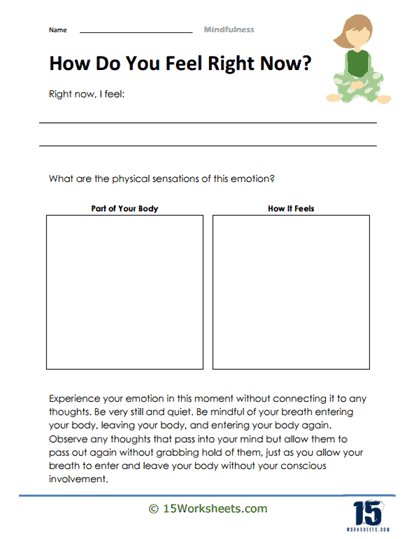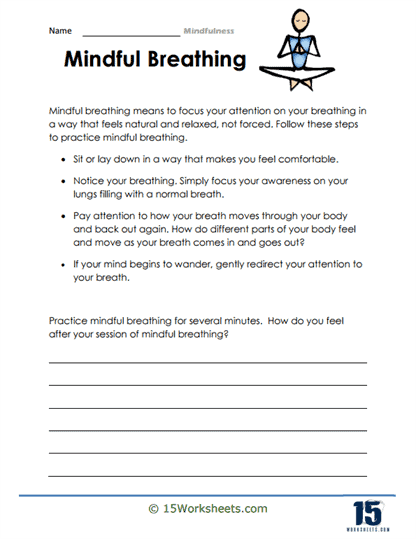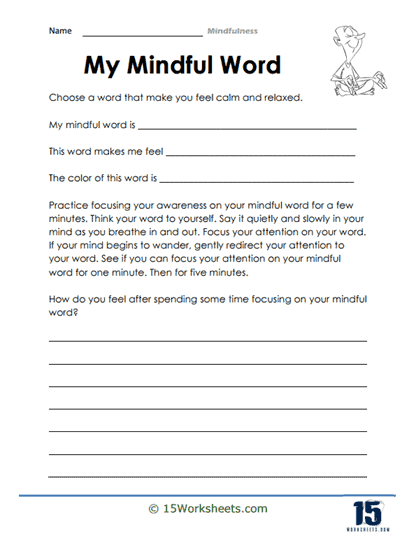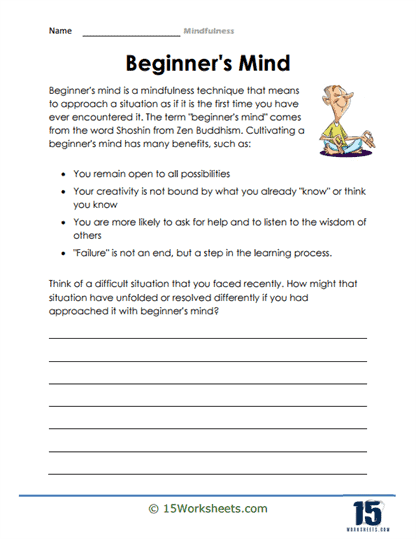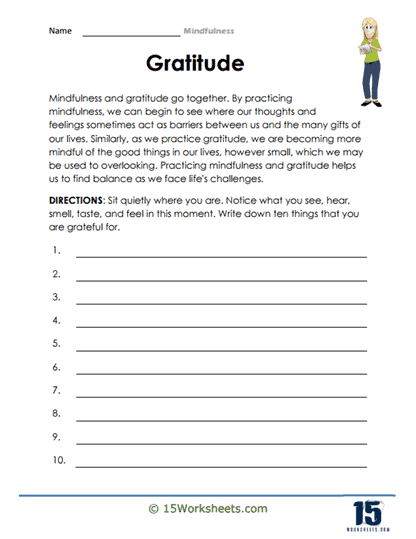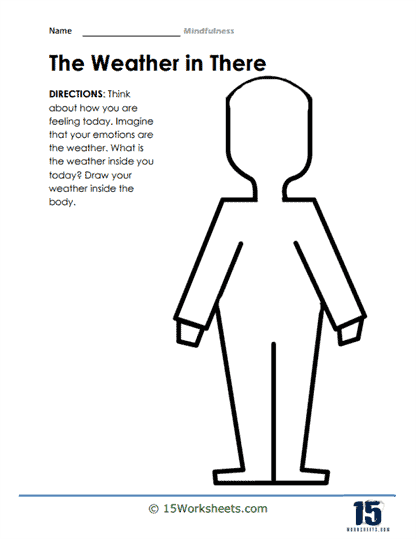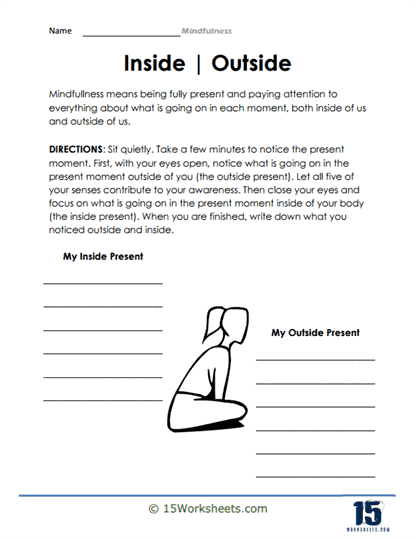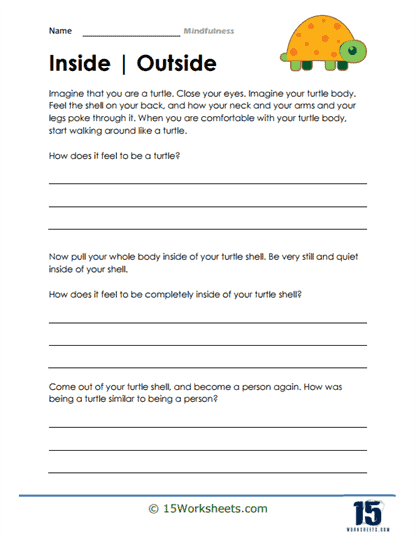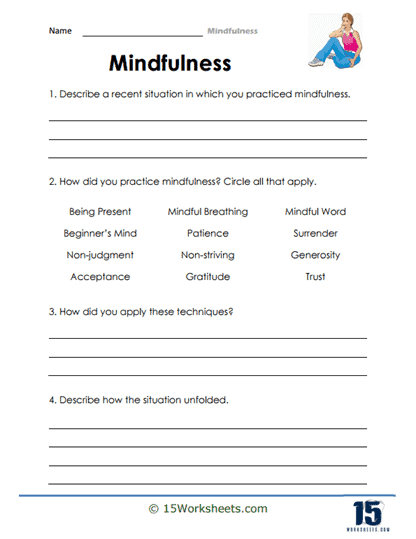Mindfulness Worksheets
All About These 15 Worksheets
In today’s fast-paced world, the ability to pause and be present in the moment can feel like a rare and elusive gift. Yet, it is a skill that can be developed with intention and practice. This series of 15 mindfulness worksheets has been carefully crafted to introduce students to the transformative power of mindfulness. Each worksheet offers practical, engaging exercises that guide students toward a deeper understanding of themselves and their surroundings, cultivating a state of present moment awareness and fostering a nonjudgmental attitude toward their thoughts and experiences.
Mindfulness, at its core, is about paying attention to the here and now with curiosity and without judgment. It is a practice that teaches individuals to step away from the constant chatter of the mind and to fully engage with the present moment. For students, who are often juggling academic pressures, social dynamics, and personal challenges, developing mindfulness skills can be especially valuable. These worksheets are designed to provide students with practical tools that they can incorporate into their daily lives, helping them navigate stress, improve focus, and enhance their emotional regulation.
One of the key benefits of mindfulness is the ability to cultivate self-awareness. Self-awareness involves a deep understanding of one’s thoughts, emotions, and behaviors, and it is a cornerstone of emotional intelligence. Through the exercises in these worksheets, students are encouraged to turn their attention inward, to observe their thoughts and feelings without judgment, and to reflect on their internal experiences with kindness and curiosity. This process of self-reflection not only promotes personal growth but also empowers students to respond to life’s challenges with greater clarity and resilience.
Among the many techniques covered in these worksheets, mindful breathing is one of the foundational practices. Breathing is something we all do automatically, yet by bringing attention to the breath, students can anchor themselves in the present moment. Mindful breathing exercises, such as deep breathing or counting breaths, help calm the nervous system and create a sense of relaxation. These practices are simple, yet powerful, offering students a tool they can use anytime, anywhere, to manage stress or anxiety.
In addition to mindful breathing, the worksheets encourage students to engage their five senses fully through mindful observation. In a world filled with distractions, we often miss the details of our environment. By slowing down and tuning into sights, sounds, smells, tastes, and textures, students can develop a heightened awareness of their surroundings. This practice not only helps them stay grounded in the moment but also enhances their appreciation for the beauty and richness of everyday experiences.
A particularly impactful exercise included in the series is mindful eating. In a culture that often promotes fast and distracted eating, taking the time to savor each bite and notice the flavors, textures, and sensations of food can be a profound experience. Mindful eating allows students to reconnect with their body’s hunger and fullness cues, promoting healthier choices and a more conscious relationship with food. This exercise is not just about nutrition—it’s about fostering a deeper connection to the act of eating and understanding how our food choices impact both body and mind.
Another aspect of mindfulness explored in these worksheets is the practice of mindful walking. Walking is an activity we often take for granted, but when done mindfully, it can be a grounding and meditative experience. By paying attention to each step, the sensation of the ground beneath their feet, and the rhythm of their movements, students can cultivate a sense of calm and presence. This practice encourages them to slow down, engage with their surroundings, and find a sense of balance, both physically and mentally.
Gratitude is another powerful component of mindfulness, and it is woven throughout the series. Reflecting on the people, experiences, and things we appreciate can shift our mindset from one of lack to one of abundance. The worksheets guide students through exercises that help them express gratitude, fostering a positive outlook and enhancing their overall well-being. Gratitude practice has been shown to improve mood, strengthen relationships, and even boost physical health, making it an invaluable tool for students as they navigate both academic and personal challenges.
Mindful journaling is another essential practice included in this series. Writing can be a powerful way to process emotions, clarify thoughts, and reflect on experiences. Through guided journaling prompts, students are encouraged to explore their inner world with honesty and compassion. This reflective practice not only promotes self-awareness but also serves as a therapeutic outlet for stress and emotional release. By regularly engaging in mindful journaling, students can develop a deeper understanding of themselves and cultivate a sense of personal growth and empowerment.
The benefits of mindfulness are well-documented, and by starting with these simple yet profound exercises, students can embark on a lifelong journey toward greater mental, emotional, and physical well-being. Through mindful breathing, observation, eating, walking, gratitude, and journaling, they will learn to engage with the present moment fully and to navigate life’s challenges with clarity and grace. These mindfulness worksheets offer a gift that students can carry with them long after they leave the classroom—the gift of being present, aware, and at peace.
What is Mindfulness?
Mindfulness is a mental state and practice that involves focusing one’s attention on the present moment while calmly acknowledging and accepting one’s feelings, thoughts, and bodily sensations. It is rooted in ancient meditation practices, particularly Buddhist traditions, but has gained widespread popularity in recent years as a secular and therapeutic technique.
Mindfulness encourages individuals to be fully present and aware of their experiences without judgment or distraction. It promotes non-reactive observation of one’s thoughts and emotions, allowing individuals to recognize patterns and cultivate a more balanced and compassionate perspective towards themselves and others.
Practicing mindfulness has been shown to have numerous psychological and physiological benefits, including reduced stress, improved mental clarity, enhanced emotional regulation, increased self-awareness, and overall well-being. Various mindfulness techniques, such as meditation, deep breathing, body scans, and mindful eating, can be used to cultivate mindfulness in daily life.
How to Improve Your Mindfulness
Improving your mindfulness involves developing a regular practice and incorporating mindfulness techniques into your daily life. Here are some steps and tips to help you enhance your mindfulness:
Establish a Daily Meditation Practice
Set aside time each day to practice mindfulness meditation, even if it’s just for a few minutes. Consistency is key, so try to make it a part of your daily routine.
Focus on Your Breath
Pay attention to your breath as a way to anchor yourself in the present moment. Notice the sensation of the air entering and leaving your body as you inhale and exhale. If your mind wanders, gently bring your focus back to your breath.
Practice Body Scans
A body scan is a mindfulness technique where you systematically bring your attention to different parts of your body, observing any sensations without judgment. This can help you become more aware of your physical presence and connect with the present moment.
Engage in Mindful Activities
Choose activities that encourage mindfulness, such as yoga, tai chi, or walking meditation. These practices combine movement with focused attention, helping you cultivate mindfulness while staying physically active.
Be Present During Routine Tasks
Bring mindfulness to everyday activities, like eating, washing dishes, or brushing your teeth. Focus on the sensations, movements, and sounds involved in the task, and try to remain fully present and engaged.
Cultivate Non-judgmental Awareness
Observe your thoughts and emotions without judging them as good or bad. Accept your experiences as they are, and remind yourself that thoughts and emotions are temporary and do not define you.
Practice Mindful Listening
When engaging in conversations, practice active listening by giving your full attention to the speaker without interrupting or planning your response. This helps you cultivate mindfulness in social interactions and fosters deeper connections with others.
Use Reminders and Cues Often
Set reminders or use visual cues, like sticky notes or phone alarms, to prompt you to practice mindfulness throughout the day.
Be Patient and Persistent
Developing mindfulness is a gradual process that requires consistent practice and patience. Remember that it’s normal for your mind to wander during mindfulness exercises. Gently bring your focus back to the present moment each time you notice it straying.
By incorporating these tips and techniques into your daily life, you can gradually improve your mindfulness, leading to increased self-awareness, emotional regulation, and overall well-being.


